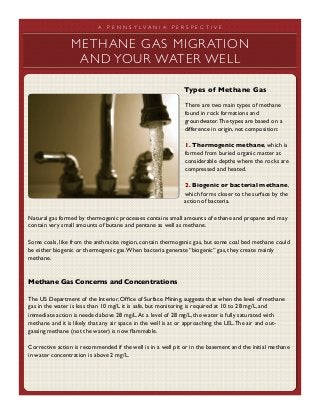
Methane Gas and Methane Gas Migration (Professional Version)
- 1. A P E N N S Y L V A N I A P E R S P E C T I V E Types of Methane Gas There are two main types of methane found in rock formations and groundwater.The types are based on a difference in origin, not composition: 1. Thermogenic methane, which is formed from buried organic matter at considerable depths where the rocks are compressed and heated. 2. Biogenic or bacterial methane, which forms closer to the surface by the action of bacteria. Natural gas formed by thermogenic processes contains small amounts of ethane and propane and may contain very small amounts of butane and pentane as well as methane. Some coals, like from the anthracite region, contain thermogenic gas, but some coal bed methane could be either biogenic or thermogenic gas.When bacteria generate “biogenic” gas, they create mainly methane. Methane Gas Concerns and Concentrations The US Department of the Interior, Office of Surface Mining, suggests that when the level of methane gas in the water is less than 10 mg/L it is safe, but monitoring is required at 10 to 28 mg/L, and immediate action is needed above 28 mg/L.At a level of 28 mg/L, the water is fully saturated with methane and it is likely that any air space in the well is at or approaching the LEL.The air and out- gassing methane (not the water) is now flammable. Corrective action is recommended if the well is in a well pit or in the basement and the initial methane in water concentration is above 2 mg/L. METHANE GAS MIGRATION AND YOUR WATER WELL
- 2. Based on a review of regulations and guidance from other states, the following are our professional recommendations related to suggested actions for your well depending on the level of methane gas detected in the water: Level 1 – PassiveVenting: Methane Levels < 2 mg/L Passive venting could simply include checking the electrical connections at the top of the well and installing a vented sanitary well cap. Level 2 – Monitoring, Source Identification, and PassiveVenting: Methane Levels 2 to 7 mg/L At this level, a passive venting system should be installed, consisting of a vented well cap using a vented piping approach. Level 3 – ActiveVenting, Removing Ignition Sources, and Seasonal Monitoring: Methane Level 7 to 10 mg/L Because the level of methane gas in the well water will fluctuate as the water level in the well changes, it would be advisable to conduct seasonal monitoring to better understand the variation in the gas concentration. In addition, this level of action would also include installing additional monitoring devices, an active venting system on the well, and an evaluation of the well to determine if a modification to the well would reduce the level of methane gas. At this time, it may be advisable to conduct an isotopic analysis to determine the likely source of the methane gas. Isotopic analysis can determine if the source of the methane gas is from landfill gas, sewer gas, biogenic gas, or thermogenic gas. Note:Any time the level of methane is at or greater than 7 mg/L - Contact- PADEP and the Local Natural Gas Company inYour Area (under Oil and Gas Law- Section 78.89). Level 4 – Aggressive, Potentially Long-Term Treatment: Methane Levels 10 mg/L to 20 mg/L At this level, it is most likely that an active ventilation system and the installation of intrinsically safe equipment will be necessary, but in the long-term it may be necessary to modify the system or install a treatment system. Before installing the treatment system, it would be advisable to complete a baseline analysis of the source and conduct additional water quality and wellbore analysis to evaluate the potential for modifying the well and aid in the design of the water treatment system.Aeration or degasification is the primary way to eliminate the problem of methane gas in water. Level 5 – Aggressive Response, Mitigation and Long-Term Treatment: Methane Levels > 20 mg/L At this level, it is likely the water has a number of aesthetic and safety issues and concerns and it may be advisable to check if the water is also influenced by elevated levels of pH, ORP (oxidation/reduction potential), barium, strontium, chloride, iron, manganese, bromide, total dissolved solids, and other elements associated with saline water. If the water is saturated with methane, i.e., > 28 mg/L, it may be advisable to retest the water/air using the IsoBag sampling method recommended by Isotech Laboratories, Inc., conduct a compositional and isotopic analysis of the gas/water and seek the assistance of a professional. For more information, visit www.water-research.net or www.bfenvironmental.com, or call 570-335-1947. © 2012 by B.F. Environmental Consultants Inc. Taking Action - Based onYour Level of Methane
